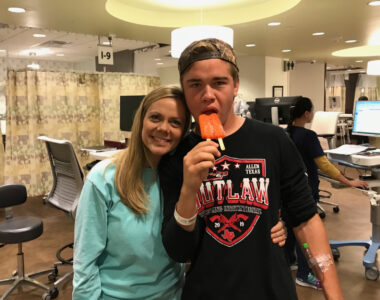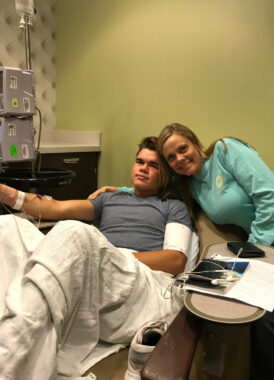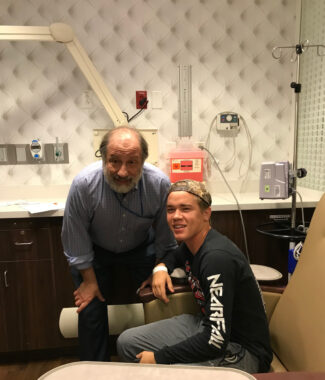Enzyme replacement therapy for Fabry is a gift and a challenge
The therapy is extremely helpful to Fabry patients, but it's not an easy process

It was a typical school day for most 17-year-olds, but for my twin sons Michael and Anthony, there was nothing ordinary about Oct. 22, 2019. It was the first day of enzyme replacement therapy (ERT) for both of them, to treat Fabry disease.
The adventure ahead was unpredictable, and navigating this new road with my sons brought ample emotions — joy and excitement about the prospect of improvement as well as fear and concern because of the unknown.
A team of competent medical professionals, pharmaceutical patient educators, and other aides had armed our family with information about the treatment the boys would be undergoing, yet even with that wide network of support, committing to ERT was no small feat. My kids, who previously had spent minimal time in doctors’ offices, were about to embark upon a lifetime of bimonthly infusions. They were taking a courageous leap of faith.

Michael VanVickle enjoys a complimentary popsicle while waiting for enzyme replacement therapy at the Baylor Scott & White T. Boone Pickens Cancer Hospital in Dallas, on Oct. 22, 2019. Joining him is his mom, columnist Susanna VanVickle. (Courtesy of Susanna VanVickle)
Lots to ponder while passing the time
ERT is designed to generate the enzyme that is nonfunctional or missing in Fabry. But we wondered if the boys would experience adverse reactions. We wondered about the space in which they would be confined for the eight-hour infusion process. We wondered how many hospital days would be endured before Michael and Anthony could be infused at home. We wondered what they would feel before, during, and after each treatment.
As devout Catholics, we started the day with early morning Mass at a beautiful abbey close to home, offering God our fears and concerns about the boys’ health and the impending treatment. Then, we fought traffic into downtown Dallas. Making our way from the crowded parking garage in the sizable medical facility to the Baylor Scott & White T. Boone Pickens Cancer Hospital within the building was itself an adventure, and I later figured out that we had spent 20 minutes walking a labyrinthine route to end up five minutes from where we had parked. Oh well, we knew better for next time.
The paperwork was not the most exasperating part of the morning — as a mom of twins, I am used to a double load — but we hadn’t expected a two-hour wait for the infusions to actually begin. As newbies, we learned that the pharmacy is unable to mix the meds until the patients are on site, and some days are particularly busy. Now we know that long waits are often part of the ERT experience.
Michael tried to make the most of the wait time by raiding the snack stash and helping himself to popsicles and sodas. Anthony braced himself for a long day but managed to smile. While we were waiting, Dr. Raphael Schiffmann showed up to check on some patients. This providential encounter was one of many silver linings of that day. His presence brought us a sense of peace and confidence as the boys settled in for the hours ahead.

Anthony VanVickle starts his first enzyme replacement therapy infusion, an hourslong process. His mom lends support. (Courtesy of Susanna VanVickle)
Acknowledging the blessings
In a world where so many people lack basic medical attention, we were grateful to be attended by fabulous nurses and given great medical care. So we began to count our blessings.
It would have been nice for the twins to be in a single, undivided room, but I was grateful they had comfortable and spacious accommodations. It would have been a relief if they were able to wander around and stretch their legs, but we were happy they had recliners and entertainment.
We would not have chosen this exhausting regimen of treatment if it weren’t necessary, but we were in this together, and we were thankful for the medical advancements that have made ERT available. My heart was particularly relieved that I could position myself to see both of my boys and accompany them through this ordeal.
In retrospect, that day was a blip on the long, arduous path of life with Fabry disease that Michael and Anthony will travel. However, the strength and courage of my sons as they began ERT is worth remembering and celebrating.
Every person who is fighting the battle of chronic illness has had to face colossal challenges that cannot be overcome in a day. Crossing a threshold, whether it is a major decision, a daunting procedure, or a promising therapy, takes determination. The journey will always have twists and turns, but we walk straight onward believing there’s hope at the end of this crooked path.

Dr. Raphael Schiffmann stops by the infusion clinic as Michael prepares for his first enzyme replacement therapy infusion. (Courtesy of Susanna VanVickle)
Note: Fabry Disease News is strictly a news and information website about the disease. It does not provide medical advice, diagnosis, or treatment. This content is not intended to be a substitute for professional medical advice, diagnosis, or treatment. Always seek the advice of your physician or other qualified health provider with any questions you may have regarding a medical condition. Never disregard professional medical advice or delay in seeking it because of something you have read on this website. The opinions expressed in this column are not those of Fabry Disease News or its parent company, Bionews, and are intended to spark discussion about issues pertaining to Fabry disease.








Leave a comment
Fill in the required fields to post. Your email address will not be published.